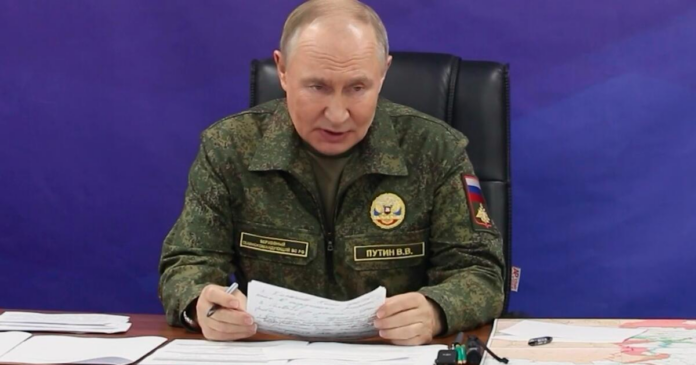Russia tested a new nuclear-capable, nuclear-powered cruise missile designed to confound existing defenses, inching closer to deploying it to its military, President Vladimir Putin said in remarks released Sunday.
The announcement, which followed years of tests of the Burevestnik missile, comes as part of nuclear messaging from the Kremlin, which has resisted Western pressure for a ceasefire in Ukraine and strongly warned the U.S. and other NATO allies against sanctioning strikes deep inside Russia with longer-range Western weapons such as the U.S.-made Tomahawk.
A video released by the Kremlin showed Putin, dressed in camouflage fatigues, receiving a report from Gen. Valery Gerasimov, Russia’s chief of general staff, who told the Russian leader that the Burevestnik covered 8,700 miles in a key test Tuesday.
Gerasimov said the Burevestnik — “storm petrel” in Russian — spent 15 hours in the air on nuclear power, adding, “That’s not the limit.”
Mysterious history
Little is known about the Burevestnik, which was code-named Skyfall by NATO, and many Western experts have been skeptical about it, noting that a nuclear engine could be highly unreliable.
When Putin first revealed that Russia was working on the weapon in his 2018 state of the nation address, he said it would have an unlimited range, allowing it to circle the globe undetected by missile defense systems.
Many observers argue that such a missile could be difficult to handle and pose an environmental threat. The U.S. and the Soviet Union worked on nuclear-powered missiles during the Cold War, but they eventually shelved the projects, considering them too hazardous.
The Burevestnik reportedly suffered an explosion in August 2019 during tests at a navy range on the White Sea, killing five nuclear engineers and two service members and resulting in a brief surge in radioactivity that fueled fears in a nearby city.
Russian officials never identified the weapon involved, but the U.S. said it was the Burevestnik.
“We need to determine the possible uses and begin preparing the infrastructure for deploying these weapons to our armed forces,” Putin told Gerasimov.
The Russian leader also claimed it was invulnerable to current and future missile defenses, because of what he said is its almost unlimited range and unpredictable flight path.
Kirill Dmitriev, a top Putin aide who was in the U.S. as the video surfaced, said his delegation informed American colleagues of the “successful testing” of the Burevestnik, which he said was an “absolutely new class” of weapon.
Last week, Putin directed drills of Russia’s strategic nuclear forces that featured practice missile launches. The exercise came as his planned summit on Ukraine with President Trump was put on hold.
The Kremlin said that the maneuvers involved all parts of Moscow’s nuclear triad, including intercontinental ballistic missiles that were test-fired from launch facilities in northwestern Russia and a submarine in the Barents Sea. The drills also involved Tu-95 strategic bombers firing long-range cruise missiles.
The exercise tested the skills of military command structures, the Kremlin said in a statement Wednesday.
Attacks in Ukraine
Meanwhile in Ukraine, Russia targeted the capital of Kyiv with drones, killing three people in their homes, authorities said early Sunday.
At least 29 people were wounded, seven of them children, in the second consecutive nighttime attack on Kyiv to claim civilian lives. Ukraine’s Interior Minister Ihor Klymenko said a 19-year-old woman and her 46-year-old mother were among the killed.
Russian drones caused fires in two residential buildings in the capital’s Desnianskyi district. Emergency crews evacuated civilians from nine-story and16-story buildings, put out flames and cleared the rubble.
Olha Yevhenivha, 74, said there was so much smoke from the fire that she couldn’t leave her apartment.
“Even until now our windows are totally black from the smoke, and it was impossible to go down, so that’s why we put wet blankets on our doors and balcony,” she said.
Ihor Motchanyi, a soccer player, said he and his parents “miraculously survived” after a drone sparked a blaze inside their home the day after his 25th birthday.
“My mother and I left. My father stayed behind in the apartment and wanted to take some documents, the most important things. He couldn’t get out because there was a fire, so he jumped down from the [third] floor” into a nearby tree, Motchanyi told the Associated Press.
He said his family was planning to temporarily leave Kyiv, and stay with relatives in a village.
Russia attacked Ukraine with 101 drones overnight into Sunday, according to Ukraine’s air force, of which 90 were shot down and neutralized. Five drones hit four locations and drone debris fell on five other places, the statement said.
The attack came a day after Russian missiles and drones killed four people, including two in Kyiv, prompting fresh pleas from Ukraine’s President Volodymyr Zelensky for Western air defense systems.
Russia’s Defense Ministry said Sunday that over the previous day its forces struck energy facilities and rail infrastructure serving Ukraine’s war effort, as well as other military targets, such as troop deployment points and a drone factory.
It did not comment specifically on strikes on Kyiv, nor on the civilian casualties reported by Ukraine.
In Russia’s Bryansk region near Ukraine, two civilians were hospitalized following Ukrainian drone strikes, according to regional Gov. Alexander Bogomaz. At least 26 Ukrainian drones were downed over southwestern Russia on Sunday, according to the Defense Ministry in Moscow.


